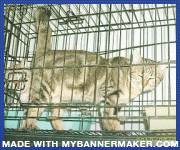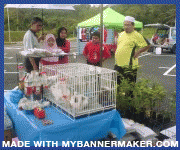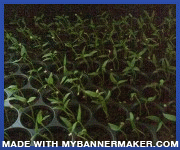There are many different colours and patterns of rabbits, particular favorites being Magpie, Harlequin, Blue and Sealpoint. Here are just a few examples.
Magpie
Magpie is the name given to the pattern, as opposed to a colour of rabbit. This has to be my favorite pattern. The rabbit is patterned like a patchwork quilt with a half black/half white face, one black ear, one white ear and with corresponding coloured feet (one front leg black, the other white, one back leg black, the other white) and then stripes of black and white across the back. This is a very difficult pattern to breed, and when a rabbit does not have the uniform patterning, it is then classed as a broken magpie (carries the magpie gene, but not perfect in pattern). My aim is to breed the perfect mini lop magpie, and also to produce a BLUE magpie (Blue/white) mini lop also, which can take many generations of breeding and can take years to perfect. The Dwarf Lop pictured on the far right above, is classed as a 'broken' magpie, as although he does not look like a magpie, he does carry the magpie genes, and therefore can re-produce magpie patterned kits (he is the father and grandfather to all the magpies pictured to the left of him)
Harlequin
Again, Harlequin is the name given to the pattern of the rabbit. The pattern should be identical to that described above for the magpie, however, the Harlequin is orange and black rather than white and black. Again, I am aiming to produce the perfect harlequin mini lop for the show table, and also I am currently working on BLUE mini lop harlequins (Blue/Orange).
Blue
Blue is a very deep, slate grey colour, and is one of the most beautiful 'self' colours found in the rabbit. When a rabbit colour is classed as a 'Self', this means that the rabbit is totally one colour, so the Blue Self is completely blue all over, and even has beautiful smoke grey/blue eyes, as shown in the picture above left. When a colour is named as a Broken (or Butterfly) this means that it is a white rabbit with a coloured nose, ears and body, the lionhead pictured above right is a broken blue.
Sealpoint SealPoint
SealPoint  Blue
Blue  Frost-Point
Frost-Point
When a rabbit is classed as n - point, this means that the extremes (points) of its body (being the nose, ears, feet and tail) are coloured and the rest of the body and belly are white/cream. The eyes of a Sealpoint/Bluepoint have a ruby glow. This particular pattern resembles the Siamese Cat. The Dwarf Lop pictured above right is a Sealpoint, whose points are a rich sepia, sable colouring, the Lionhead pictured next is a Blue-Point, and then the Lionhead Lop to the right is a Frostpoint, whose extremes are much more faint and he does not have a ruby glow to his eye. n-Points' tend to start off all white, and the colouring of the extremes becomes darker as they grow.
Smoke
Smoke is from the same colour group as the sealpoint, and has the same patterning as the Sealpoint and Sooty Fawn (below), however the main overall colouring is a 'diluted' blue (smokey grey)
Sooty Fawn/Fawn
Fawn is a light brown/burnt orange colour. 'Sooty' Fawn is fawn all over the body, with darker 'sooty' extremes. This pattern is very similar to the sealpoint pattern mentioned above, however, where the body is cream with a sealpoint, it is orange with the sooty fawn. It is also possible to produce 'broken' fawn (white and fawn) as shown in the pictures above right.
Sable
Sable is also from the same 'colour group' as the Sealpoint, Sooty Fawn and Smoke. Sable is a beautiful rich, deep sepia (deep chocolate) colour with darker extremes. 'Siamese' Sable does turn slightly lighter across the body through the moult, they are the chameleon of the rabbit world as they seem to change colour throughout the year and are beautiful to watch.
Agouti
Agouti is the name given to the pattern of the rabbit, and is the same pattern as the wild rabbit. If you blow into the fur of an Agouti rabbit, you will see 'bandings' of different colours along the shaft of the hair, being blue, black, tan, fawn. The Agouti also has light tan colouring around the nostrils and at the back of the neck. The belly is cream. The above pictures show an agouti and a 'broken' agouti (white/agouti).
Chinchilla
Chinchilla is the name given to the grey version of the Agouti. Again, the colour is not a colour as such, but a pattern, and this is made up of various bands of different colours along the shaft of the fur. Do not mistake this 'COLOUR' for the name given to the completely different species of small animal called a Chinchilla.
Albino (Pink/Ruby Eyed White)
The Ruby/Pink Eyed White (REW) is the Albino of the rabbit world. The Albino is completely white with red eyes. The eyes are red because of the lack of coloured pigmentation. Ruby Eyed whites are quite short sighted, and can often be seen slowly moving their head from side to side as if in a trance, this is called 'Scanning' and is perfectly normal behaviour. once the rabbit has the object in focus, it will come out of the scan.
Otter
Otter is the name given to the pattern, and is a member of the 'Tan' pattern group. Otters are mainly seen in Black and Blue. Basically the Otter is a 'self' colour (eg. pure black or blue) over most of the body, with a white/cream belly and inside the ears, and tan colouring behind the ears, and trim of the nose and skirt (where body colour meets belly colour). They are a very attractive colouring.





































"Ruby Eyed whites are quite short sighted, and can often be seen slowly moving their head from side to side as if in a trance, this is called 'Scanning' and is perfectly normal behaviour. once the rabbit has the object in focus, it will come out of the scan."
ReplyDeleteTQ Abg. Sham...akhirnya trjwb jugak persoalan kenape rabbit saye dok geleng2...:)
Sama2....sama2 share ilmu....hehehe....
ReplyDelete